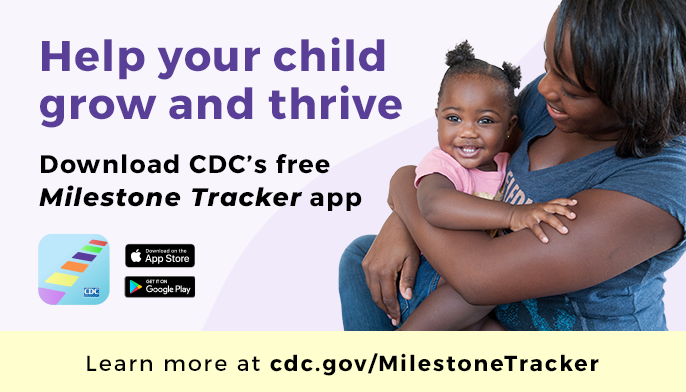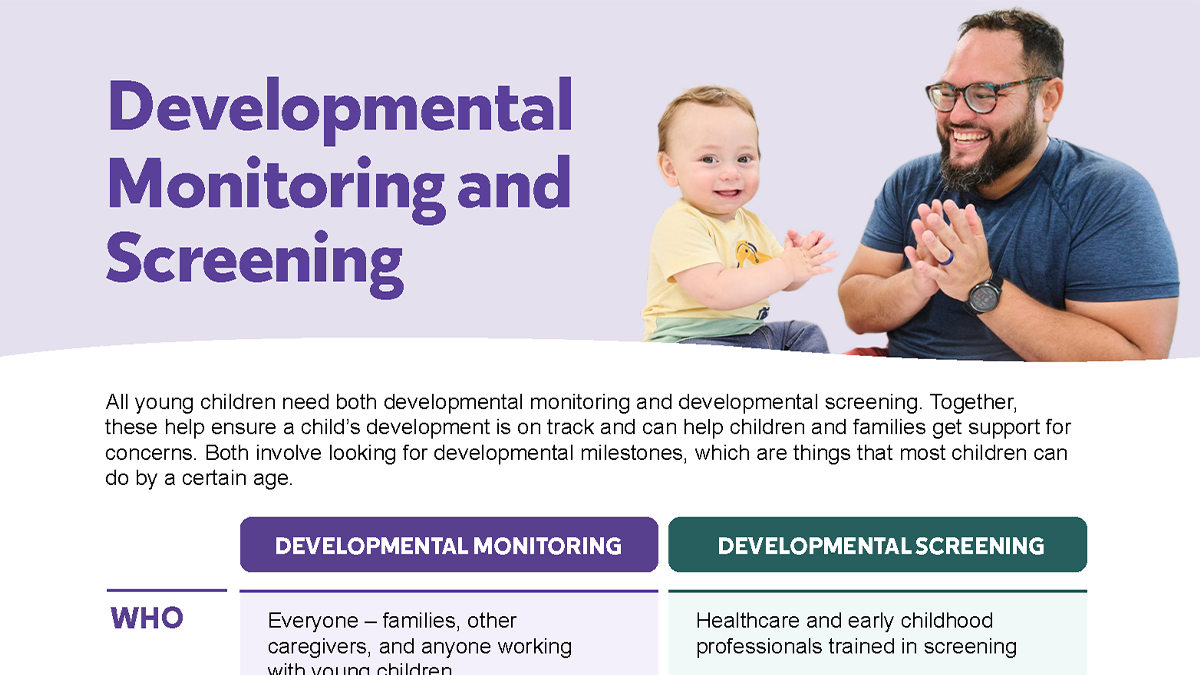What to know
- Developmental monitoring and screening are important for all young children, to check how they are developing over time.
- Together, they can help identify potential developmental delays, and help young children and families get any needed services as early as possible.

Developmental monitoring
Developmental monitoring is observing how a child grows and changes over time to see whether they are reaching developmental milestones in how they play, learn, speak, act, and move at each age. Parents, grandparents, early childhood providers, and other caregivers can participate in developmental monitoring. You can use a brief checklist of milestones to see how a child is developing. If you notice that your child is not meeting a milestone, talk with your child's doctor.
When you take your child to their doctor for each well-child visit, talking about child development is important. Your child's healthcare provider will ask questions about their development while interacting with your child to see if they are meeting milestones that most children their age can do. A missed milestone could be a sign of a developmental delay. If your child is missing a milestone, or if either of you have concerns about how they are developing, the doctor may do a developmental screening test as the next step. By asking questions and sharing any concerns you might have with your child's doctor, you can understand how your child is doing, and learn ways to support your child's development.
Developmental screening
Developmental screening takes a closer look at how your child is developing. The tools used for developmental screening are formal questionnaires or checklists based on research that ask questions about a child's development, including language, movement, thinking, behavior, and emotions. Developmental screening can be done by your child's health care provider, and by other professionals in healthcare, early childhood education, community, or school settings who have been trained in using these tools.
Developmental screening is more formal than developmental monitoring and is recommended for all children at specific ages.
The American Academy of Pediatrics (AAP) recommends developmental screening for all children during regular well-child visits at least at these ages1:
- 9 months
- 18 months
- 30 months
In addition, AAP recommends that all children be screened specifically for autism during regular well-child visits at:
- 18 months
- 24 months
If your child misses one of these well-child visits, or a screening was not done at those times, it should be completed at the next visit. Your child should also receive a screening at other times if you or your child's doctor have a concern about their development.
If your child's healthcare provider does not periodically check your child with a developmental screening test, you can ask them to do so.
Developmental monitoring and screening
Developmental Monitoring
WHO: Everyone – families, other
caregivers, and anyone working
with young children
WHAT: Look for developmental milestones
WHEN: Early childhood, especially from birth to 5 years
WHY:
To help:
- celebrate a child's development
- talk about a child’s progress with doctors, child care providers, teachers, and other professionals
- learn what to expect next
- identify any concerns early
Developmental Screening
WHO: Healthcare and early childhood professionals trained in screening
WHAT: Look for developmental milestones
WHEN:
Developmental Screening at 9, 18, and 30 months of age
Autism Screening at 18 and 24 months of age
Additional screenings can be done for concerns
WHY:
To find out:
- if a child needs more support; it is not always easy to know whether a child needs help with development
- if further evaluation is recommended
Why developmental monitoring and screening are important
Identifying developmental delays and disabilities early helps children and families. Developmental monitoring and screening work together to help identify developmental concerns, so that children and families can get the services and supports they need as early as possible.
Early developmental intervention services support the child, helping them at home, in school, and in the community.
Developmental disabilities are common. In the United States, about 1 in 6 children aged 3 to 17 years has one or more developmental disabilities, such as autism or attention-deficit/hyperactivity disorder.
Early intervention and follow-up
When a developmental concern is identified, further evaluation through the state's early intervention system is often the next step. Healthcare providers, and anyone who works with young children, can refer families to early intervention for assessment. Families can also refer themselves directly.
Connecting to the early intervention system will lead to more steps to assess the child's development. Depending on those results, the child may be eligible to receive services from the program to help the family support their child's development.
Each state and territory has their own system for children who are eligible.
- State early intervention programs usually provide developmental services for children from birth to 3 years of age, with some states also serving older children
- Local public school systems typically provide developmental services and support for children age 3 years and older
This early intervention page provides a brief overview of services and eligibility processes, along with key contacts for each state and territory.
Although early intervention is important, intervention at any age can be helpful. Contact your child's doctor or your state program if you have any concerns about your child's development.
- Lipkin PH, Macias MM, Council on Children with Disabilities, Section on Developmental and Behavioral Pediatrics (2020). Promoting optimal development: Identifying infants and young children with developmental disorders through developmental surveillance and screening. Pediatrics, 145(1), e20193449.


